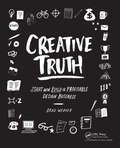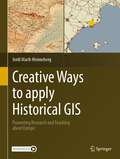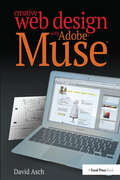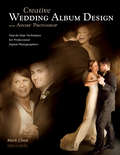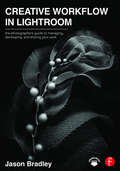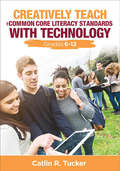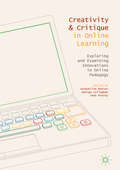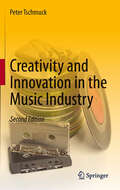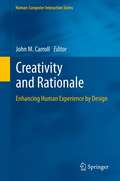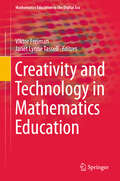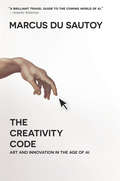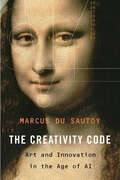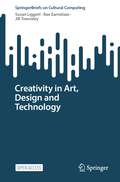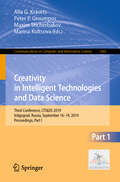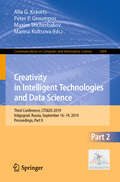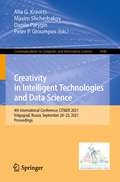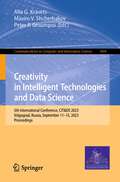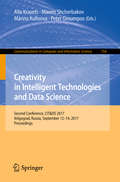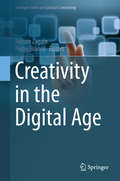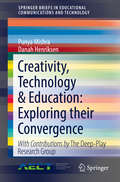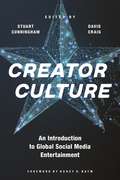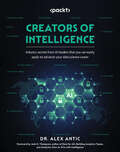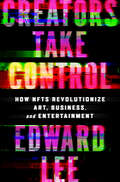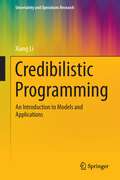- Table View
- List View
Creative Truth: Start & Build a Profitable Design Business
by Brad WeaverCreative Truth is your playbook for starting, building, and enjoying a profitable design business. Whether you’re a solo freelancer working from home or a small group of creative entrepreneurs ready to get to the next level, this is your roadmap to success. You’re the CEO, CFO, CTO, Secretary, Janitor, Office Manager, and everything in between. Finding a balance between running the business and doing great creative work is a constant struggle. From learning how to price your work and manage your time, to setting up your business and defining your market, Brad Weaver covers everything designers need to know to run a studio without losing heart. <P><P>Highlights: <li>Real numbers, real tools, and best practices in a toolkit that you can start using immediately in your business. <li>A companion website that offers up-to-date resources, articles, tools, and discussions, allowing readers to continue learning as they grow. <li>Practical tips for getting clients, being more profitable, building your network, managing your operations, getting things done, hiring help, managing contractors, and finding joy along the way.
Creative Ways to apply Historical GIS: Promoting Research and Teaching about Europe
by Jordi Martí-HennebergThis volume promotes the use of Historical GIS (H-GIS) for both education and research. It consists of a coherent set of chapters that allow readers to study the spatial histories of cities, infrastructure, landscapes, and more across Europe. Each chapter is accompanied by Electronic Supplementary Material (ESM) including GIS data, guides and complementary material in .pdf format, and more. To date, there are no similar materials available in this field compiled in a single book. Interdisciplinarity in spatial research is a main theme of this volume, and the text and tools provided here allow readers to combine inputs relating to the study of earth sciences, population, urban growth and transportation, focusing on changes over both space and time. Each chapter provides data in GIS format and also a user's guide to enable readers to deeply engage with the contents themselves. Guidelines are provided to help locate new data about other areas of the world, which users will be able to develop independently. The book is divided into three parts, each presenting different scales of study and analysis at the local, regional and national levels. Part One deals with general subjects analyzed across large areas, mainly within Europe. Part Two provides more specific subjects and data. Part Three covers sources and teaching with H-GIS. The book will be of interest to researchers, academics, teachers and students from secondary schools up to university level. Each subject and tutorial is aimed at a multi-level audience.
Creative Web Design with Adobe Muse
by David AschYou’ve found your Muse; now learn how to create with it Creative Web Design with Adobe Muse is a step-by-step guide to creating fully-featured websites using Adobe Muse. Adobe Muse can be a complicated program, and web design itself is no easy task, although your clients might think so. This book takes you from the initial design and layout stage right up to helping you publish your beautifully designed and richly developed site. Each chapter covers a different section of the website and, in turn, introduces the tools and features of the program, accompanied by useful tips and tricks that help you speed up your workflow. Follow along as a website is created from concept to execution and rich content such as slideshows, galleries, and social media are incorporated. See how each aspect of a website is created with Muse; watch as it’s published; and visit the final version after learning how it was made. If seeing a website created start to finish wasn’t enough, this book also features: Tips on how to incorporate Photoshop into Muse A companion website that was created with Muse where you can get up-to-the-minute coverage on Muse and other tutorials to help you design the perfect website Through this perfect blend of instruction and inspiration, you’ll be up and running with Adobe Muse in no time.
Creative Wedding Album Design with Adobe Photoshop
by Mark ChenPairing photographic creativity with digital-manipulation techniques, this unique manual teaches the use of Photoshop to design artful, distinctive, and compelling wedding albums. Showing that the artistic process need not stop at the click of the shutter, the steps for album creation are detailed reviewing the images, forming a story line, and conveying the tale through well-designed montages. Offering 10 projects with varying levels of complexity and covering diverse skill sets, step-by-step techniques are demonstrated with detailed screen shots--
Creative Workflow in Lightroom: The photographer’s guide to managing, developing, and sharing your work
by Jason BradleyAdobe’s Lightroom has emerged as a must-have software due to its powerful editing tools and time saving organizational capabilities but how you establish a personalized, creative workflow that optimizes this technology, your time, and your art eludes most photographers. Jason Bradley, award-winning photographer and Lightroom pro, shares the answers to these questions in this practical and easy to follow guide that taps into the "how" and the "why" of a professional photographer’s creative workflow in Lightroom. Bradley will show you how all workflows can be simplified into three steps: establishing, managing, and rendering the file, alongside stunning photographs and explanations from his own experiences. This book will not only teach you how to work within Lightroom but, ultimately, how to make Lightroom work for you.
Creatively Teach the Common Core Literacy Standards With Technology: Grades 6-12 (Corwin Teaching Essentials)
by Catlin R. TuckerLet technology pave the way to Common Core success. Engage your students by delving into the Common Core ELA standards with the tools they use the most. As you explore the creative road to academic success, with the Common Core ELA and literacy standards—you will turn your classroom into a student-centered learning environment that fosters collaboration, individualizes instruction, and cultivates technological literacy. Features include: Specific recommendations for free apps and tech tools that support the Common Core Step-by-step guidelines to breaking down standards by grade and subject Teacher-tested, research-supported lesson ideas and strategies Replicable resources, including prewriting activities and writing templates Real-life examples
Creatively Teach the Common Core Literacy Standards With Technology: Grades 6-12 (Corwin Teaching Essentials)
by Catlin R. TuckerLet technology pave the way to Common Core success. Engage your students by delving into the Common Core ELA standards with the tools they use the most. As you explore the creative road to academic success, with the Common Core ELA and literacy standards—you will turn your classroom into a student-centered learning environment that fosters collaboration, individualizes instruction, and cultivates technological literacy. Features include: Specific recommendations for free apps and tech tools that support the Common Core Step-by-step guidelines to breaking down standards by grade and subject Teacher-tested, research-supported lesson ideas and strategies Replicable resources, including prewriting activities and writing templates Real-life examples
Creativity and Critique in Online Learning: Exploring and Examining Innovations in Online Pedagogy
by Jacqueline Baxter George Callaghan Jean McAvoyThis book explores emerging practices in distance education that have been facilitated by the development of educational technology. The volume examines core themes in distance education including online education at scale, embodiment in online environments, connectivity in online education and the personalisation of learning experiences within online education. The first section of the book examines online teaching tools, and explores how they are being used to enhance and promote student learning. The second looks at some of the broader challenges encountered by online teachers and those responsible for designing online learning material. While this volume will be of significant interest to distance learning universities and colleges, it will also be a valuable resource to traditional Higher Education Institutions, who are increasingly searching for innovative ways to reach and teach their students. This edited collection will be of value to scholars of online education as well as practitioners and policy makers looking to enrich their notions of online pedagogy.
Creativity and Innovation in the Music Industry
by Peter TschmuckWhy did jazz become a dominant popular music genre in the 1920s and rock 'n' roll in the 1950s? Why did heavy metal, punk rock and hiphop find their way from sub-cultures to the established music industry? What are the effects of new communication technologies and the Internet on the creation of music in the early 21st century? These and other questions are answered by Peter Tschmuck through an integrated model of creativity and innovation that is based on an international history of music industry since Thomas A. Edison invented the phonograph in 1877. Thus, the history of the music industry is described in full detail. By discussing the historic process of music production, distribution and reception the author highlights several revolutions in the music industry that were caused by the inference of aesthetic, technological, legal, economic, social and political processes of change. On the basis of an integrated model of creativity and innovation, an explanation is given on how the processes and structures of the present music industry will be altered by the ongoing digital revolution, which totally changed the value-added network of the production, dissemination and use of music. For the second edition, the author has reworked chapter 9 in order to include all the developments which shaped the music industry in the first decade of the 21st century - from Napster to cloud-based music services and even beyond.
Creativity and Rationale: Enhancing Human Experience by Design (Human–Computer Interaction Series #20)
by John M. CarrollCreativity and rationale comprise an essential tension in design. They are two sides of the coin; contrary, complementary, but perhaps also interdependent. Designs always serve purposes. They always have an internal logic. They can be queried, explained, and evaluated. These characteristics are what design rationale is about. But at the same time designs always provoke experiences and insights. They open up possibilities, raise questions, and engage human sense making. Design is always about creativity. Creativity and Rationale: Enhancing Human Experience by Design comprises 19 complementary chapters by leading experts in the areas of human-computer interaction design, sociotechnical systems design, requirements engineering, information systems, and artificial intelligence. Researchers, research students and practitioners in human-computer interaction and software design will find this state of the art volume invaluable.
Creativity and Technology in Mathematics Education (Mathematics Education in the Digital Era #10)
by Viktor Freiman Janet Lynne TassellThis volume provides new insights on creativity while focusing on innovative methodological approaches in research and practice of integrating technological tools and environments in mathematics teaching and learning. This work is being built on the discussions at the mini-symposium on Creativity and Technology at the International Conference on Mathematical Creativity and Giftedness (ICMCG) in Denver, USA (2014), and other contributions to the topic. The book emphasizes a diversity of views, a variety of contexts, angles and cultures of thought, as well as mathematical and educational practices. The authors of each chapter explore the potential of technology to foster creative and divergent mathematical thinking, problem solving and problem posing, creative use of dynamic, multimodal and interactive software by teachers and learners, as well as other digital media and tools while widening and enriching transdisciplinary and interdisciplinary connections in mathematics classroom. Along with ground-breaking innovative approaches, the book aims to provide researchers and practitioners with new paths for diversification of opportunities for all students to become more creative and innovative mathematics learners. A framework for dynamic learning conditions of leveraging mathematical creativity with technology is an outcome of the book as well.
The Creativity Code: Art and Innovation in the Age of AI
by Marcus Du SautoyMost books on AI focus on the future of work. But now that algorithms can learn and adapt, does the future of creativity also belong to well-programmed machines? To answer this question, Marcus du Sautoy takes us to the forefront of creative new technologies and offers a more positive and unexpected vision of our future cohabitation with machines.
The Creativity Code: Art and Innovation in the Age of AI
by Marcus du SautoyMost books on AI focus on the future of work. But now that algorithms can learn and adapt, does the future of creativity also belong to well-programmed machines? To answer this question, Marcus du Sautoy takes us to the forefront of creative new technologies and offers a more positive and unexpected vision of our future cohabitation with machines.
Creativity in Art, Design and Technology (Springer Series on Cultural Computing)
by Susan Liggett Rae Earnshaw Jill TownsleyThis is an open access book.Creativity is a difficult concept, how can it best be defined, understood, applied, and practiced? This book provides important answers to these questions. Technology can enable artists to be more creative. Scientific and artistic thinking give us two complementary tools to understand the complexity of the world, with science reducing subjective experience to essential principles and art intensifying and expanding our experiences. These examples also show how artists can push the boundaries of technology into exciting new realms that have not been explored before. The impact that art and art practice can have on culture, society, and social responsibility is explored in detail through examples and case studies. In addition, the book presents how artists are creating and reflecting cultural and societal resonance in their work. Can other disciplines help artists to be more creative? All are part of an interrelated wider society and enables artists to develop artwork fit for highly interfaced and conceptually broad contemporary contexts. This is illustrated with examples which show exciting and challenging results. Creativity in Art, Design and Technology is relevant for artists, designers, scientists and technologists. All can benefit in a major way from a greater understanding of creativity, and the ways in which mutual interaction and collaboration enables all areas to develop. The potential for the future is immense and this book signposts the way forward.
Creativity in Intelligent Technologies and Data Science: Third Conference, CIT&DS 2019, Volgograd, Russia, September 16–19, 2019, Proceedings, Part I (Communications in Computer and Information Science #1083)
by Alla G. Kravets Peter P. Groumpos Maxim Shcherbakov Marina KultsovaThis two-volume set constitutes the proceedings of the Third Conference on Creativity in Intellectual Technologies and Data Science, CIT&DS 2019, held in Volgograd, Russia, in September 2019.The 67 full papers, 1 short paper and 3 keynote papers presented were carefully reviewed and selected from 231 submissions. The papers are organized in topical sections in the two volumes. Part I: cyber-physical systems and Big Data-driven world. Part II: artificial intelligence and deep learning technologies for creative tasks; intelligent technologies in social engineering.
Creativity in Intelligent Technologies and Data Science: Third Conference, CIT&DS 2019, Volgograd, Russia, September 16–19, 2019, Proceedings, Part II (Communications in Computer and Information Science #1084)
by Alla G. Kravets Peter P. Groumpos Maxim Shcherbakov Marina KultsovaThis two-volume set constitutes the proceedings of the Third Conference on Creativity in Intellectual Technologies and Data Science, CIT&DS 2019, held in Volgograd, Russia, in September 2019.The 67 full papers, 1 short paper and 3 keynote papers presented were carefully reviewed and selected from 231 submissions. The papers are organized in topical sections in the two volumes. Part I: cyber-physical systems and Big Data-driven world. Part II: artificial intelligence and deep learning technologies for creative tasks; intelligent technologies in social engineering.
Creativity in Intelligent Technologies and Data Science: 4th International Conference, CIT&DS 2021, Volgograd, Russia, September 20–23, 2021, Proceedings (Communications in Computer and Information Science #1448)
by Alla G. Kravets Maxim Shcherbakov Danila Parygin Peter P. GroumposThis book constitutes the proceedings of the 4th Conference on Creativity in Intellectual Technologies and Data Science, CIT&DS 2021, held in Volgograd, Russia, in September 2021.The 39 full papers, 7 short papers, and 2 keynote papers presented were carefully reviewed and selected from 182 submissions. The papers are organized in the following topical sections: Artificial intelligence and deep learning technologies: knowledge discovery in patent and open sources; open science semantic technologies; IoT and computer vision in knowledge-based control; Cyber-physical systems and big data-driven control: pro-active modeling in intelligent decision making support; design creativity in CASE/CAI/CAD/PDM; intelligent technologies in urban design and computing; Intelligent technologies in social engineering: data science in social networks analysis and cyber security; educational creativity and game-based learning; intelligent assistive technologies: software design and application.
Creativity in Intelligent Technologies and Data Science: 5th International Conference, CIT&DS 2023, Volgograd, Russia, September 11–15, 2023, Proceedings (Communications in Computer and Information Science #1909)
by Alla G. Kravets Maxim V. Shcherbakov Peter P. GroumposThis book constitutes the proceedings of the 5th Conference on Creativity in Intellectual Technologies and Data Science, CIT&DS 2023, held in Volgograd, Russia, in September 2023.The 40 regular papers and 2 keynote papers presented were carefully reviewed and selected from 148 submissions. The papers are organized in the following topical sections: Artificial intelligence and deep learning technologies for creative tasks. Knowledge discovery in patent and open sources; Artificial intelligence & Deep Learning Technologies for Creative tasks. Open science semantic technologies; Artificial intelligence and deep learning technologies for creative tasks. Computer vision and knowledge-based control; Cyber-physical systems and big data-driven control: pro-active modeling in intelligent decision making support; Cyber-Physical Systems & Big Data-driven world. Industrial creativity in CASE/CAI/CAD/PDM; Cyber-Physical Systems & Big Data-driven world. Intelligent Internet of Services and Internet of Things; Intelligent Technologies in Social Engineering. Data Science in Social Networks Analysis and Cyber Security; Intelligent Technologies in Social Engineering. Creativity & Game-Based Learning; Intelligent Technologies in Social Engineering. Intelligent Technologies in Medicine& Healthcare; Intelligent Technologies in Social Engineering. Intelligent technologies in Urban Design&Computing.
Creativity in Intelligent Technologies and Data Science: Second Conference, CIT&DS 2017, Volgograd, Russia, September 12-14, 2017, Proceedings (Communications in Computer and Information Science #754)
by Alla Kravets Maxim Shcherbakov Marina Kultsova Peter GroumposThis book constitutes the refereed proceedings of the First Conference on Creativity in Intelligent Technologies and Data Science, CIT&DS 2015, held in Volgograd, Russia, in September 2015. The 66 revised full papers and two short papers presented were carefully reviewed and selected from 208 submissions. The papers are organized in topical sections on computational creativity for science and design; knowledge discovery in patent and open sources for creative tasks; software computer-aided design and agent-based systems; conceptual, cognitive and qualitative modeling with application in intelligent decision making; design creativity in CAD/CAM/CAE/PDM; intelligent decision support for continual improvement process; data science in energy management, transportation and urban development; data science in social networks analysis; natural language and image processing and analysis; game-based learning technologies in engineering education and educational games design; personalized learning in Web-based intelligent educational systems; e-inclusion: development of smart mobile applications for people with disabilities.
Creativity in the Digital Age (Springer Series on Cultural Computing)
by Nelson Zagalo Pedro BrancoThis edited book discusses the exciting field of Digital Creativity. Through exploring the current state of the creative industries, the authors show how technologies are reshaping our creative processes and how they are affecting the innovative creation of new products. Readers will discover how creative production processes are dominated by digital data transmission which makes the connection between people, ideas and creative processes easy to achieve within collaborative and co-creative environments. Since we rely on our senses to understand our world, perhaps of more significance is that technologies through 3D printing are returning from the digital to the physical world. Written by an interdisciplinary group of researchers this thought provoking book will appeal to academics and students from a wide range of backgrounds working or interested in the technologies that are shaping our experiences of the future.
Creativity, Technology & Education: Exploring their Convergence (SpringerBriefs in Educational Communications and Technology)
by Danah Henriksen Punya MishraIn this collection of beautifully written essays, Mishra, Henriksen, and the Deep-play Research Group challenge myths about technology and creativity, debate time-honored instructional practices, and play with new ideas for schools to care for and nurture, rather than constrain, creativity. These essays are provocative . . . refreshing, [and] insightful --Dr. Yong Zhao, Foundation Distinguished Professor, University of Kansas and Fellow, Mitchell Institute for Health and Education Policy, Victoria University, Australia. What is creativity? Why is it important? What does it look like across different disciplines and contexts? What role does technology play, if any, in the creative process? And finally, what do creativity and technology have to do with education? These are the questions that underlie the collection of articles in this book. These essays provide a broad analytic frame for thinking about creativity, technology and education and describe classroom examples as well as strategies for evaluating creative artifacts and creative environments. All of these are grounded in specific examples from across a wide range of disciplines and contexts--art, mathematics, engineering, computer science, graphic design, architecture, science to name just a few. The final essays take a broader perspective on creativity and technology focusing both on our highly inter-connected YouTube world but also possibilities for the future. Creativity, Technology & Education: Exploring their Convergence is a vital resource for educators and practitioners as they seek to incorporate creative work and thoughtful pedagogy in their personal and professional lives.
Creator Culture: An Introduction to Global Social Media Entertainment
by Stuart Cunningham David CraigExplores new perspectives on social media entertainmentThere is a new class of cultural producers—YouTube vloggers, Twitch gameplayers, Instagram influencers, TikTokers, Chinese wanghong, and others—who are part of a rapidly emerging and highly disruptive industry of monetized “user-generated” content. As this new wave of native social media entrepreneurs emerge, so do new formations of culture and the ways they are studied.In this volume, contributors draw on scholarship in media and communication studies, science and technology studies, and social media, Internet, and platform studies, in order to define this new field of study and the emergence of creator culture. Creator Culture introduces readers to new paradigms of social media entertainment from critical perspectives, demonstrating both relations to and differentiations from the well-established media forms and institutions traditionally within the scope of media studies.This volume does not seek to impose a uniform perspective; rather, the goal is to stimulate in-depth, globally-focused engagement with this burgeoning industry and establish a dynamic research agenda for scholars, teachers, and students, as well as creators and professionals across the media, communication, creative, and social media industries.Contributors include: Jean Burgess, Zoë Glatt, Sarah Banet-Weiser, Brent Luvaas, Carlos A. Scolari, Damián Fraticelli, José M. Tomasena, Junyi Lv, Hector Postigo, Brooke Erin Duffy, Megan Sawey, Jarrod Walzcer, Sangeet Kumar, Sriram Mohan, Aswin Punathambekar, Mohamed El Marzouki, Elaine Jing Zhao, Arturo Arriagada, Jeremy Shtern, Stephanie Hill
Creators of Intelligence: Industry secrets from AI leaders that you can easily apply to advance your data science career
by John K. Thompson Dr. Alex AnticGet your hands on the secret recipe for a rewarding career in data science from 18 AI leadersPurchase of the print or Kindle book includes a free PDF eBookKey FeaturesGain access to insights and expertise from data science leaders shared in one-on-one interviewsGet pragmatic advice on how to become a successful data scientist and data science leaderReceive guidance to overcome common pitfalls and challenges and ensure your projects' successBook DescriptionA Gartner prediction in 2018 led to numerous articles stating that "85% of AI and machine learning projects fail to deliver.” Although it's unclear whether a mass extinction event occurred for AI implementations at the end of 2022, the question remains: how can I ensure that my project delivers value and doesn't become a statistic? The demand for data scientists has only grown since 2015, when they were dubbed the new “rock stars” of business. But how can you become a data science rock star? As a new senior data leader, how can you build and manage a productive team? And what is the path to becoming a chief data officer? Creators of Intelligence is a collection of in-depth, one-on-one interviews where Dr. Alex Antic, a recognized data science leader, explores the answers to these questions and more with some of the world's leading data science leaders and CDOs. Interviews with: Cortnie Abercrombie, Edward Santow, Kshira Saagar, Charles Martin, Petar Velickovic, Kathleen Maley, Kirk Borne, Nikolaj Van Omme, Jason Tamara Widjaja, Jon Whittle, Althea Davis, Igor Halperin, Christina Stathopoulos, Angshuman Ghosh, Maria Milosavljevic, Dr. Meri Rosich, Dat Tran, and Stephane Doyen.What you will learnFind out where to start with AI ethics and how to evolve from frameworks to practiceDiscover tips on building and managing a data science teamReceive advice for organizations seeking to build or mature a data science capabilityStop beating your head against a brick wall – pick the environment that'll support your successRead stories from successful data leaders as they reflect on the successes and failures in data strategy developmentUnderstand how business areas can best work with data science teams to drive business valueWho this book is forThis book is for a wide range of audience, from people working in the data science industry through to data science leaders and chief data officers. This book will also cater to senior business leaders interested in learning how data and analytics are used to support decision-making in different domains and sectors. Students contemplating a career in artificial intelligence (AI) and the broader data sector will also find this book useful, along with anyone developing and delivering university-level education, including undergraduate, postgraduate, and executive programs.
Creators Take Control: How NFTs Revolutionize Art, Business, and Entertainment
by Edward LeeA leading legal scholar offers a compelling new theory to explain the meteoric rise of non-fungible tokens (NFTs) and their impact on art, business, entertainment, and society, and explains how they are revolutionizing our understanding of ownership.If you buy an NFT, do you own anything? Critics say no. Then why are people spending so much money to own them—to the tune of $27 billion in 2021? And why are big businesses and venture capital firms investing hundreds of millions to develop NFTs for people’s use in the metaverse, a purely imaginary world? In Creators Take Control, Edward Lee offers a compelling new theory he calls “Tokenism” that answers these perplexing questions. Using vivid examples, Lee lucidly explains how NFTs operate—and how they fundamentally change our understanding of ownership. Tokenism is an artistic, cultural, and technological movement that creates value in a new kind of ownership of a new type of property—symbolized by a virtual token—through a process of technological abstraction and artificial scarcity effectuated by NFTs. Ownership becomes virtual. What Cubism did in radically changing the twentieth-century perspective of creating and viewing art through cubes, Tokenism does today in altering our perspective of owning art and other things through tokens. Both movements radically reimagine what’s possible. Creators and businesses have seized upon this profound transformation. In a short time, they have developed a new market for digital art, important new rights for creators, innovative business models based on decentralized collaboration, and a new type of interactive ownership that enables identity, community, and patronage through NFTs. These innovations are just the start of revolutionary changes to society. Lee shows how NFTs create a new form of decentralized intellectual property, or De-IP. Comparable to the movement to decentralized finance (DeFi), De-IP empowers creators to take control of their artistic productions and livelihood. Lee’s intellectual tour de force is filled with practical insights—and hope—for fostering creativity and a Virtual Renaissance for the ages.
Credibilistic Programming: An Introduction to Models and Applications (Uncertainty and Operations Research)
by Xiang LiIt provides fuzzy programming approach to solve real-life decision problems in fuzzy environment. Within the framework of credibility theory, it provides a self-contained, comprehensive and up-to-date presentation of fuzzy programming models, algorithms and applications in portfolio analysis.
